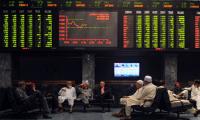ISLAMABAD: Pakistan’s inflation rate rose to 29.66 percent in December 2023, up from 29.2 percent in the previous month. However, core inflation, excluding food and energy costs, reached a ten-month low at 18.2 percent. This down tick may prompt State Bank of Pakistan (SBP) policymakers to consider easing the discount rate next month to stimulate economic activities and growth.
The increase in headline inflation measured by the Consumer Price Index (CPI), is attributed to elevated food and energy costs, deviating from the government’s earlier forecast of 25.5 to 26.5 percent in early December. In November, inflation saw a 0.8 percent uptick, compared to a 2.7 percent increase the previous month and 0.5 percent in December 2022.
Notably, earlier in November CPI surged to 29.2 percent from October’s 26.9 percent, primarily due to a significant gas tariff hike. In December, it rose further to 29.66 percent, driven mainly by an increase in electricity costs, notably positive monthly fuel price adjustments (FCA).
The spike in housing and utility costs, rising 37.68 percent from November’s 32.97 percent, is a key factor, with this category carrying nearly one-fourth of the weightage in the CPI basket. On a month-to-month basis, these items became 3.56 percent costlier than the previous month.
For the first half of the fiscal year (July-Dec 2023-24), average inflation stood at 28.8 percent, exceeding the government’s target of 21 percent and the State Bank of Pakistan’s range of 20 to 22 percent.
Food inflation in December YoY was 27.5 percent, slightly lower than the previous month’s 27.95 percent, but on a month-to-month basis, it decreased by 0.49 percent.
Alcoholic beverages and tobacco maintained an inflation rate of 82.8 percent, increasing by 0.5 percent over November.
Recreation and culture costs decreased to 38.48 percent, lower than the 53.56 percent recorded in November. Communication charges YoY was 7.4 percent in December and the same was in the previous month. Education is also at 13.5 percent almost unchanged on a YoY basis, and on a MoM basis, it increased by 0.23 percent.
Transport expenses increased to 28.6 percent from 26.5 percent in the previous month. Over the previous month, the transportation charges were 0.8 percent costlier in December.
Hotel and restaurant charges in December were 30.7 percent higher than a year ago and in November it was 31.4 percent. Over the previous month, it was however higher by 0.72 percent.
Furnishings experienced an increase of 0.9 percent over the previous month while over the same month of last year, it was 32.5 percent expensive. Health expenses in a month increased by 0.7 percent and 23.36 percent in a year.
Core inflation, a key factor in policy rate decisions, has been on a monthly increase but declined on a YoY basis. In January 2023, it was 15.4 percent, with subsequent months recording fluctuations until reaching 18.2 percent in December. In other months i.e. February 2023 it was 17.1 percent, March 18.6 percent, April 19.5 percent, May 20 percent (which recorded high), June 18.5 percent, July and August at 18.4 percent each, September 18.6 percent, October 18.5 percent, and November at 18.6 percent.
The wholesale price index (WPI), a measure of producer prices, rose to 27.3 percent in December from 26.4 percent in November. The sensitive price indicator (SPI), which tracks the prices of essential items on a weekly basis, was recorded at 35.3 percent against 30.6 percent in November.
Urban inflation was at 30.9 percent and rural at 27.9 percent. In the previous month, urban inflation was at 30.4 percent and rural at 27.5 percent.
On a month-on-month basis, onions price increased by 30.8 percent, dry fruits 5.2 percent, masoor pulse 5.1 percent, eggs 4.7 percent, pan prepared 4.4 percent, gram pulse 3.7 percent, fish 3.2 percent, sugar 2.5 percent, wheat 2.2 percent, pulse moong 2 percent, mash pulse 1.2 percent, wheat flour 0.8 percent, powder milk 0.3 percent and meat 0.2 percent.
However, tomatoes price reduced 42pc, potatoes 18.6pc, tea 8.6pc, chicken 4.2pc, gur 3.5pc, vegetable ghee 2.7pc, rice 2.7pc, fresh vegetables 2.2pc, fresh fruits 1.65pc, cooking oil 1.6pc, condiments and spices 1.45pc, whole gram 0.76pc.
Among non-food items, on MoM basis, electricity charges increased by 15.76pc, transport services 12pc, woolen readymade garments by 4.02pc, solid fuel by 2.4pc, construction input items by 0.67pc, household equipment by 0.62pc, dental services by 0.6pc, construction wage rates 0.54pc. However, motor fuel charges were reduced by 2.4pc over the previous month.
On a year-on-year basis, fresh vegetable prices increased by 65.41pc, wheat flour 59pc, sugar 49pc, potatoes 47pc, rice 46pc, mash pulse 44pc, wheat products 39pc, tea 38pc, masoor pulse 32pc, wheat 29pc, eggs 27pc, fresh milk 22pc, tomatoes 21pc, fish 20pc, meat 17pc, chicken 17pc, moong pulse 13pc, whole gram 12pc, gram pulse 3.9pc, fresh fruits 3.2pc and cooking oil 2.6pc.
However, onion prices were reduced by 17.7 percent, mustard oil by 4.2 percent, and vegetable ghee by 1.2pc.
Likewise, among the non-food items, on a yearly basis, gas charges were up by 520 percent, electricity charges 61.6pc, transport services 38.2pc, drugs and medicines 32.4pc, doctor (MBBS) clinic fee 25pc, hospitals services 23.5pc, motor fuel 22.5pc, motor vehicles 22pc, construction input items 20.3pc, solid fuel 19.4pc, dental services 11pc, water supply 16pc, medical tests 15pc, tailoring 14.5pc, construction wage rates 12.7pc, education 12.7pc, household servant 12.2pc, postal services 11.5pc and house rent increased by 5.6 percent over same month of last year.
Biden avoided the large protests at the front of the hotel by arriving through a back entrance
Raoof believed that a younger and ideological cadre had emerged in the party during the last two years
CM expressed her views on the World Day of Safety and Health at Workplace
Schofer said that the US was also supporting a program to empower female students through sports in Punjab
Rival Chinese automakers such as Xpeng 9868.HK have been seeking to gain an advantage over Tesla by rolling out...
The Al Maktoum airport will also include 400 terminal gates and five runways







